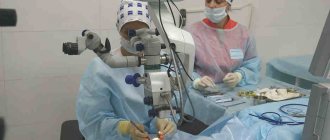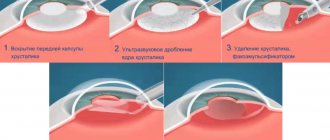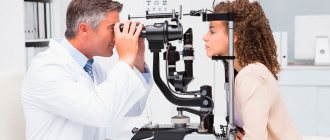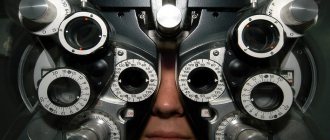Early difficulties
Blepharoplasty can cause serious complications after surgery
.
Let's take a closer look at each of these conditions and how you can cope with them.
Edema
Swelling of soft tissues is inherent in all surgical interventions without exception, which involve damage to the integrity of soft tissues.
When the patient has edema (in the affected area of the skin), vascular permeability increases, which leads to swelling.
This condition is considered normal after this operation. It lasts from two to seven days. Swelling can also cause blurred vision and headaches.
In order to get rid of them, you need to use anti-inflammatory ointments and gels, which will be prescribed by your doctor.
Hematoma
A hematoma can develop in the first hours after surgery or several days after it is performed.
There are three types of hematomas:
- subcutaneous
- characterized by the accumulation of ichor just under the top layer of skin due to impaired vascular function. It is eliminated using a catheter, which is inserted under the skin and pumps out excess fluid; - tense
– accompanied by profuse subcutaneous bleeding. It must be urgently eliminated by restoring the affected vessel; - retrobulbar
is the most dangerous hematoma that can develop due to damage to a large vessel. In this case, patients will experience an accumulation of blood under the eyeball. This can lead to blurred vision and pain. Such a hematoma is removed surgically.
Diplopia
Its symptoms appear almost immediately after the operation.
Most often, with diplopia, the work of the oblique muscle of the eye is disrupted. As a rule, this condition goes away on its own after 1-2 months.
Bleeding
Bleeding is the most common complication observed after blepharoplasty. It can also occur during the operation itself.
The danger with this condition is that the patient may lose too much blood, requiring additional plasma or blood transfusions. This in turn threatens blood poisoning.
Eversion of the lower eyelid
Because this operation can remove so much skin, patients sometimes experience lower eyelid inversion after the procedure. At the same time, the eye itself cannot close completely, which leads to its dryness.
In order to eliminate this condition, it is necessary:
- perform additional surgery;
- do a special massage for the eye to maintain and stretch muscle tone.
Infection of postoperative wounds
If sterility is violated during this surgical procedure, the patient runs the risk of infection in the wound.
This condition manifests itself in the form of an inflammatory process, high temperature and discharge of pus from the sutures.
Also, if an infection gets into the wound, the latter will take much longer to heal.
Orbital hemorrhage
Orbital hemorrhage is considered the most terrible consequence of blepharoplasty, as it threatens complete loss of vision.
This complication can result from a surgeon’s mistake or performing surgery on a patient with the following contraindications:
- hypertension;
- taking anticoagulants or alcoholic beverages before surgery;
- carrying out a long and complex operation.
This condition usually manifests itself within the first day after eyelid correction. It is very difficult to treat.
The most effective therapy is repeated surgery, but in severe cases there is no guarantee that lost vision will be restored.
Functional complications of blepharoplasty
After blepharoplasty, the manifestation of the so-called “dry eye syndrome” may be observed - its signs may be a decrease in tear production, a feeling of dryness and burning of the eyes. This complication usually develops in people who, even before surgery, suffered from insufficient tear production. If dry eyes are caused by incorrect position of the lower eyelid after surgery, then canthopexy is performed for correction.
Often the opposite manifestation can occur - excessive tearing of the eyes, caused by increased irritation of the lacrimal gland. After the sutures are removed, the manifestations of this complication go away on their own.
Incomplete closure of the palpebral fissure, called lagophthalmos, may be normal in the early postoperative period, but prolonged persistence indicates excessive excision of eyelid tissue. Depending on the degree of manifestation of the complication, drug therapy may be prescribed - to stretch the skin of the eyelids or repeated blepharoplasty. If the tension in the lower eyelid is too great, perhaps because a lot of skin has been removed, the outer corners of the eye may droop, giving the patient a “sad” appearance. If initially the tissue tone of the lower eyelid was sharply reduced or a lot of skin was removed from the lower eyelid, then it may be pulled down excessively - this condition is called ectropion . This complication of blepharoplasty most often resolves on its own within some time after the operation. If complications persist, canthopexy is performed.
The occurrence of ectropion of the lower eyelid with a correctly performed surgical technique is extremely rare.
Reasons for appearance
Complications after eyelid correction using plastic surgery can have different origins. The reasons are divided into several groups:
Failure to comply with the conditions of preparation for blepharoplasty and postoperative rehabilitation. Usually the patient is informed about what is permitted and prohibited during these periods. Ignoring the rules can cause most complications. For example, taking blood-thinning medications provokes bleeding, swelling, and makes healing difficult. So after this you can expect any problem. The same thing happens when the patient does not want to give up smoking, starts physical activity too early, does not take good care of the stitches, and refuses procedures aimed at accelerating recovery. Even dietary disturbances, which should be light after blepharoplasty, can cause complications.
Features of the patient's body. To a greater extent, this relates to the process of scar formation. If blepharoplasty is the first procedure performed, the tendency to form hypertrophied and keloid scars on the eyelids may be an unpleasant surprise.
Diagnostic measures
The patient can recognize eyelid inversion independently. During the examination, the doctor confirms the diagnosis, determines the symptoms of complications, and establishes the cause.
The following signs help the doctor determine the type of pathology:
- the presence of a scar indicates the development of cicatricial ectropion. In this case, the eyelid can be easily given a physiological position by pulling the skin to the side;
- during the examination, the doctor may notice the appearance of neoplasms, which indicates the development of mechanical eversion;
- reduced sensitivity or its absence indicates the development of paralytic ectropion.
What to do if a medical error occurs
If, after blepharoplasty, in the patient’s opinion, a medical error occurred, then this fact must be documented. For this:
- You will need to undergo examination and examination at an independent clinic specializing in eyelid surgery.
- Collect original documents certified by the seals of the clinic where the blepharoplasty was performed.
- Provide supporting documentation of the operation being performed by a specific surgeon.
- The original contract with the clinic for eyelid correction in the clinic.
It is almost impossible to independently prove the presence of a medical error after plastic surgery. Therefore, in this case, you will need the help of a qualified lawyer. If you have the originals of all documents confirming that blepharoplasty was performed in the blade, the percentage of positive outcomes in litigation increases.
What can a patient claim?
If the procedural case regarding medical errors after unsuccessful blepharoplasty is carried out correctly, the patient can claim:
- Repeated blepharoplasty.
- Correction of negative consequences, both physiological and aesthetic.
- Completion of a rehabilitation course.
- Compensation for moral and material damage.
- Termination of the surgeon's medical practice and deprivation of the clinic's license to perform plastic surgery.
Don't be afraid to seek the help of lawyers. Often such cases end in favor of the patient. The clinic or doctor provides complete recovery after surgery, maintaining its positive reputation.
Aesthetic complications of blepharoplasty
Complications may arise during any operation . In addition to the surgeon’s error, the cause of such consequences can be the individual characteristics of the body. In such a situation, it is important to immediately contact a specialist who can both identify the cause of the complication and offer competent methods for its correction. Blepharoplasty is a highly individual operation; in addition to the correctly performed technique of the operation, the structure and shape of the eyes, as well as the anatomical features of the patient and his aesthetic preferences must be taken into account.
Upper blepharoplasty - complications and correction methods
The problems that can arise during unsuccessful blepharoplasty on the upper and lower eyelids are radically different. In upper eyelid surgery, the incision is made at the level of the skin fold, so that after the operation it remains invisible. During the operation, excess skin of the upper eyelid must be excised, fat hernias must be straightened and removed. Poorly performed upper blepharoplasty can cause a number of complications:
– excessive removal of the skin of the upper eyelid – this complication does not require special surgical intervention, since the skin stretches on its own, after a fairly short period of time, if necessary, injections of a drug can be offered to stretch the skin;
– insufficient excision of the skin – a complication in which a repeat operation is performed, during which excess skin is removed;
– excessive excision of fatty hernias/skeletonization of the upper eyelid – the complication is corrected by lipofilling.
Lower blepharoplasty - complications and correction methods
– ptosis of the lower eyelid, the vector of eyelid tension is directed downwards, the complication is caused by excessive removal of the skin of the lower eyelid – correction can be surgical when the patient is asked to perform canthopexy (an operation to strengthen the outer edge of the lower eyelid), in our clinic supplemented, as a rule, with lipofilling of the outer corner of the eye to create a supportive cushion. Or medications to stretch the skin - used no earlier than six months after the initial operation.
In the article “Repeat blepharoplasty” you can see in the photo complications caused by unsuccessful blepharoplasty and proposed methods for correcting them.
Possible
This category of complications after blepharoplasty, which do not always occur, but only when the postoperative and rehabilitation period is improperly managed:
- infection is a consequence of bacteria entering a postoperative wound, manifested by inflammatory processes with the possible formation of pus, this complication develops when the rules of antiseptics and asepsis are not observed during or after surgery, treatment consists of prescribing antibiotics (ceftriaxone) and washing the eyes and eyelids with antiseptic solutions (furatsilin , chlorhexedine);
- ectropion – inversion of the lower eyelids after blepharoplasty, which leads to their incomplete closure, increased dryness and keratosis of the sclera of the eyeball, treatment is only surgical, consisting of plastic surgery of the tissues and muscles of the lower eyelid;
- diplopia – double vision, caused by damage to the muscles of the eyeball after surgery, treatment consists of mandatory surgical plastic surgery of the damaged muscles with restoration of their integrity;
- Deterioration of vision is a serious complication that has many causes in its occurrence, namely a tense hematoma, leading to a deterioration in the nutrition of the retina, dry keratoconjunctivitis, which can cause the formation of an eyesore; all these causes require immediate adequate treatment.
Laser blepharoplasty allows you to minimize late and possible complications, due to the virtual absence of significant trauma to the skin and subcutaneous tissue of the eyelids.
Early complications of blepharoplasty are minimal; with proper management of the postoperative period, they resolve on their own and do not require special treatment.
These recommendations include:
- avoiding taking medications that reduce blood clotting (aspirin, acetylsalicylic acid);
- avoiding physical activity after surgery;
- a cold compress on the eyelids to prevent and reduce tissue swelling;
- You cannot use makeup after surgery;
- using special eye drops or artificial tears to prevent keratoconjunctivitis sicca;
- the use of antiseptic solutions or ointments for the eyelids will eliminate infectious complications;
- avoiding excessive insolation (exposure to sunlight) on postoperative wounds will make it possible to prevent most complications of blepharoplasty;
- the effect of high temperatures on the skin of the eyelids after surgery can increase swelling, inflammation, and provoke late bleeding, so you should avoid visiting a bathhouse or sauna.
Myth 2: After blepharoplasty, hollows formed under the eyes
Most often, this sensation occurs in patients in the presence of large hernias that fill the lower eyelid area so much that when they are removed, a transition between the cheek-zygomatic region and the lower eyelid can be visible.
An experienced plastic surgeon can easily solve this problem. During the consultation, most likely, when asked how to remove hollows under the eyes after blepharoplasty, you will be asked to remove hernias, which spoil the appearance and negatively affect the condition of the skin. The patient may appear tired, swollen and painful. To prevent the formation of this pathology, you can use lipofilling, which is the injection of your own fat into the desired area.
However, recently, fewer and fewer surgeons are using this method. Over time, more than half of the injected substance disappears, and additional correction is required. And this again means unpleasant manipulations with the face, a rehabilitation period, and additional costs of time and money. Naturally, patients do not like all these negative aspects.
Today, the Light&Tight technique is popular, the essence of which is transconjunctival removal of the hernia. that is, without making an incision. Immediately after the manipulation, the cosmetologist will perform a thermolifting procedure, due to which the skin of the eyelids will tighten. Thus, the patient receives two procedures at once, with minimal complications and unpleasant sensations.
How to detect an eversion of the eyelid?
Typically, diagnosing extropion is not difficult: the defect can be seen by the patient himself in the mirror.
When visiting a doctor, an ophthalmologist performs standard examinations:
- External examination, which allows us to determine the presence of decreased tone of the periorbital muscle, the degree of atony, swelling of the skin, the degree of non-closure of the eyelid (lagophthalmos), the presence of tumors or scars.
- Biomicroscopy will help to examine the conjunctiva, the edges of the eyelid in more detail, and assess the size of the pathology in more detail.
- Visometry and perimetry. These studies will evaluate the impact of eversion on quality of vision.
- Computer keratometry to clarify the diagnosis.
- A series of laboratory tests on eyelid scrapings and some blood tests.
After the examination, a form of treatment for eyelid inversion is selected.
Advice. Seek advice from an ophthalmology clinic that performs ophthalmological surgeries. This way, you won’t have to do the same examinations twice.
Definition of disease
Eversion of the eyelid is divided into several types, depending on the etiology. More precise symptoms are also associated with the species, on the basis of which the doctor makes a diagnosis:
- Congenital ectropion. This type of disease is autosomal hereditary and rarely occurs on its own (for example, the pathology is often associated with ptosis, epicanthus inversus, or blepharophimosis). Disappears spontaneously as the face grows. Relatively often affects the upper eyelids. The therapy consists of suturing the lateral edges of the eyelids and moving or transferring the skin.
- Involutional (atonic) eversion of the eyelid. It is the most common form of the disease. It is especially common in the lower eyelid in elderly patients, in whom the problem is caused by weakening of the tissue and paralysis of the pretarsal part of the orbicularis oculi muscle. The disease is accompanied by significant lacrimation, hyperemia and hypertrophy of the conjunctiva. The therapy consists of horizontal shortening of the eyelid at the site of the temporal (motor) edge, as a result of which re-adhesion (sufficient adherence) of the eyelid to the eyeball is achieved.
- Paralytic ectropion. As a result of reduced function of the circular eye muscle (m. orbicularis oculi), a person cannot completely close the eyelids, which often causes the development of lagophthalmos. The cause is often considered to be paresis of the facial nerve n.VII. Therapeutic methods include suturing the edges of the eyelid, that is, tarsography.
- Cicatricial ectropion. Occurs, in particular, as a result of tension caused by scars on the skin of the eyelids and around them (often these are formed as a result of burns, including chemical burns, trauma or cancer of the eyelids). The treatment is quite complex: Z-plasty is performed on the site of traction scars. In the case of extensive processes, the cords are excised and the skin is covered plastically from the second eyelid or from the mastoid area (processus mastoideus).
Eversion of the eyelid (another name for ectropion) by definition is a persistent defect characterized by a change in position (lag) of the ciliary edge directly from the eyeball. This is accompanied by exposure of the conjunctiva of the eye.
The mechanism of action of the disease lies in the cartilage that supports the eyelid. It is he who, under the influence of certain reasons, can turn out together with the eyelid itself. Eversion of the lower eyelid is more common; pathology of the upper eyelid is extremely rare and is usually associated with the anatomy of the eye.
Eyelid surgery for inversions and inversions
Entropion can be a congenital abnormality of the eyelid position, in which the edge of the eyelid with the eyelashes growing on it is turned towards the eyeball. Inversion of a small part of the eyelid or the entire eyelid may occur. In some cases, the inversion can be significant and the entire eyelid curls inward along with the eyelashes. In this case, severe pain occurs, since the eyelashes irritate the cornea, can cause minor damage, scratches of the cornea, which can result in degenerative, ulcerative processes in the cornea and its clouding.
Also, entropion of the eyelid often occurs after burns, after inflammatory processes of the eyes (diphtheria, trachoma). In this case, the volvulus is cicatricial due to the formation of scars in the eyelids and conjunctiva. With severe spasm of the eyelids, spastic inversion of the eyelid may occur. More often it occurs on the lower eyelid. And quite a lot of cases of spastic inversion of the eyelid occur in elderly patients, due to the fact that the skin of the eyelids is flabby and stretched.
With eversion of the eyelid, the ciliary edge of the eyelid is not adjacent to the eyeball, but is turned outward. Eversion of the eyelid can be of a minor degree, when the eyelid is simply loosely attached to the eyeball or droops somewhat; with a more significant degree, the mucous membrane (conjunctiva) turns outward in a small area or throughout the entire eyelid. The conjunctiva is visible above the ciliary edge. Eversion can develop with inflammatory diseases of the eyelids and conjunctiva - spastic inversion. Paralytic eversion of the eyelid occurs in diseases of the facial nerve (facial nerve neuropathy) due to weakness of the orbicularis oculi muscle. Atonic eversion of the eyelid occurs in old age due to loss of tone of the orbicularis oculi muscle and stretching and atrophic changes in the skin. Cicatricial eversion of the eyelid is a consequence of traumatic lesions of the eyelid, burns.
Any degree of eversion of the eyelids is always accompanied by profuse lacrimation and damage to the skin due to the fact that it is constantly wet. The conjunctiva dries out and thickens. Various infectious processes may develop. Ultimately, the cornea may become damaged and corneal ulceration (keratitis) may occur.
Useful tips
- physiotherapy;
- microcurrents;
- laser resurfacing;
- eye exercises;
- massage;
- mesotherapy;
- medicinal and cosmetic preparations.
As a rule, they are used after the rehabilitation period (after 2 weeks) to speed up the healing process.
Microcurrents
Microcurrents after blepharoplasty help rapid recovery. After the procedure, the following processes occur:
- relieves inflammation and fatigue;
- excess fluid is removed and swelling on the eyelids is reduced;
- lymph outflow improves;
- wound healing accelerates;
- muscles relax and recover.
Microcurrent therapy is also used to prevent the formation of keloid scars after blepharoplasty.
Mesotherapy
Stimulates metabolic processes, improves blood circulation and promotes cell restoration. During the procedure, injections with medicinal preparations are injected under the skin in the eyelid area, which contain amino acids, vitamins, herbal components and other beneficial substances.
Laser resurfacing
During the procedure, the desired areas are exposed to a carbon dioxide laser and the upper stratum corneum of the skin is cleaned. The session lasts 30–60 minutes.
After laser exposure, a slight burning sensation and peeling on the eyelids may occur, which will subside within 10 days. Laser resurfacing is prescribed no earlier than 2 months after eyelid blepharoplasty.
Drugs
They are used for the eyes after surgery, when it is necessary to relieve inflammation, restore dermal receptors, strengthen blood vessels, prevent the formation of blood clots and improve the general condition of the eyelids.
Popular means:
Lyoton - will help get rid of swelling, remove bruises, inflammation, relieve pain;
Lokoid - relieves swelling and inflammation, disinfects;
Dermatix is used to strengthen capillaries, eliminate pigmentation and soften scar tissue;
Troxevasin will also help remove bruises and swelling from the eyelids;
The drugs Kelo-lot and Contractubex work well for smoothing scars after blepharoplasty.
Among the cosmetics and folk remedies that help alleviate the condition of the eyelids during the rehabilitation period, the following can be used:
- gels with caffeine, retinol, Chinese mushroom extract;
- decoctions of chamomile, sage, juice of parsley leaves, linden, which are used as compresses for eyelids.
Eye drops
Prescribed in the first two to three days after blepharoplasty to prevent drying out and infection in the eyelid area, since the eyes are still slightly open. This could be Levomycetin or Albucid. They need to be instilled every 3-4 hours, two drops. If plastic surgery of the lower eyelids was performed, Solcoseryl gel is placed into their inner surface (conjunctiva) overnight.
Gymnastics
Regardless of whether blepharoplasty of the upper or lower eyelids was performed, special gymnastics are prescribed during the rehabilitation period. It helps tone muscles, increase blood circulation and restore eye functionality.
It is better to do it twice a day: morning and evening.
Basic exercises:
- Focus your gaze on a point above, below, left and right.
- Raise your face up and blink continuously for 30 seconds.
- Close your eyes, then open your eyes and immediately focus your gaze on a distant point in front of you.
- Place your index fingers on your temples and lightly pull the skin to the sides. The eyes are closed.
- Close your eyes and cover your eyelids with your index fingers. Without lifting your fingers (without pressure), look up.
- Tilt your head back and focus your gaze on the tip of your nose. Relax.
Each exercise should be repeated 5-7 times, with the exception of the second.
Lymphatic drainage massage
To avoid complications associated with blepharoplasty, your doctor may recommend massage. The procedure helps improve blood circulation, remove toxins and improve the functioning of lymph flows. Each movement must be performed 10 times, pressing your fingers pointwise clockwise in the following places:
- on the temples;
- from the outer edge of the lower eyelid to the inner;
- on the wings of the nose;
- moving along the upper eyelid, press from the inside of the eye to the temple.
Any physical procedures and other therapy after blepharoplasty help to recover faster. But they also have contraindications and side effects. Therefore, you should talk to your doctor about the advisability of their use.
Myth 1: You can go out immediately after blepharoplasty
After surgery in the area of the upper or lower eyelids, this is almost impossible. An important role is played by the individual characteristics of the patient, age, and the rate of skin regeneration. Plastic surgeons strongly recommend following the recommendations and resting for at least 7 days after the operation. In some cases, the recovery period is even longer – up to two weeks. This depends on the complexity of the intervention performed. The main consequence of any facial surgery is swelling and hematomas. They significantly spoil the appearance, so it is unlikely that it will be noticeable to outsiders that the face has been corrected. It is still better to go out in public after eyelid surgery when the effect is more noticeable and the hematomas have disappeared.
Contraindications
There is a list of indications for which blepharoplasty should be avoided:
- problems with blood clotting;
- suffered a heart attack or stroke;
- complex stages of diabetes mellitus;
- blood pressure problems;
- retinal detachment;
- tumor neoplasms;
- kidney and liver diseases;
- period of critical days;
- pregnancy or lactation;
- diseases associated with inflammation of the eyelids;
- infectious diseases;
- inflammation of the tear ducts;
- conjunctivitis.
Failure to comply with contraindications can lead to irreversible consequences.
Blepharoplasty is completely contraindicated in the following cases:
- For hypertension
- Endocrine disorders, incl. hypo- and hyperthyroidism
- Serious diseases of the heart and blood vessels
- Kidney failure
- For diabetes
- For diagnosed eye diseases: glaucoma, xerophthalmia, retinal detachment
You should not have blepharoplasty if less than a year has passed since the previous intervention, or if you have recently undergone a serious illness or major surgery.
This operation is indicated for people in the following cases:
- Having bags under the eyes.
- Presence of wen under the eyes.
- Severe wrinkles on the lower eyelid.
- Sagging of the upper eyelid.
- Having a “heavy” look.
- The presence of various birth defects or pathologies of the eyelid.
- Acquired (after injury, surgery or burn) eyelid defects.
- Drooping of the corners of the eyes.
- Excess flesh on the lower eyelids.
Before agreeing to this operation, you must remember the following contraindications to its implementation:
- diabetes mellitus type 1 and 2;
- the presence of an inflammatory process in the body, which is accompanied by high temperature;
- acute or chronic respiratory diseases;
- hepatitis;
- severe infectious diseases;
- presence of oncological pathologies;
- pregnancy and breastfeeding;
- the patient's age is up to eighteen years;
- dry eye syndrome;
- blood clotting disorder;
- acute diseases of internal organs;
- hypertension;
- increased intracranial pressure;
- dysfunction of the thyroid gland;
- infectious diseases of the eyes or nose.
Contraindications include any acute infectious and inflammatory diseases, as well as chronic ailments at the acute stage (in such cases it is better to undergo the necessary course of therapy and wait for recovery).
The operation is not performed during menstruation.
Xerosis of the eyes (dry mucous membrane) is also a limitation to therapy.
The procedure is not performed if the patient has high blood or intraocular pressure.
Contraindications include systemic blood diseases, as well as blood clotting disorders (high risk of bleeding).
Contraindications also include cancer, diabetes and hormonal imbalances (especially when it comes to thyroid diseases).
This is why it is important to undergo a full examination before scheduling surgery.
Blepharoplasty (eyelid surgery)
Blepharoplasty or eyelid surgery is a plastic surgery during which excess fatty tissue is removed from the upper and lower eyelids, and in some cases, sagging skin that appears as a result of age-related changes in the facial skin around the eyes is removed.
Starting from the age of 30, every person begins to show the first signs of aging; the periorbital area of the face is primarily subject to such changes. Visual manifestations of this process are bags under the eyes, wrinkles, and drooping of the upper eyelid.
Most often, the operation is indicated for people after 35 years of age and older, but if necessary, no one will forbid you to have the operation at a younger age. You should be wary of surgery if you have high blood pressure or dry eyes, as well as thyroid disease, cardiovascular disease, or diabetes.
Getting rid of ectropion after blepharoplasty with surgery
There are two options for correcting this problem - conservative and surgical. In the first situation, massage and gymnastics are used to increase the tone of the orbicularis oculi muscle. Depending on the type of pathology, the age of the patient, and the condition of the facial tissues, different surgical techniques can be used. To select them, the doctor relies on the following factors:
- why did the inversion appear;
- what is the condition of the soft tissues in the eyelid area: excess or deficiency;
- the degree of weakness of the ligaments that fix the corners of the eye in a particular state;
- presence of scars and other skin damage.
The general essence of surgery is to move the injured musculocutaneous structure of the eyelid to the correct position and secure it. This can only be done by a plastic surgeon or an ophthalmologist in a special department. The preparatory stage begins with a meeting with the surgeon, after which the patient will need to undergo tests. The list of studies is as follows:
- general blood and urine tests;
- platelet count test;
- blood chemistry;
- electrocardiogram;
- fluorography.
Depending on age and health status, additional studies and consultations with specialists may be indicated. If the intervention will be performed under general anesthesia, it is additionally necessary to consult with an anesthesiologist. The operation itself lasts from 1 to 3 hours, it all depends on the chosen technique and the complexity of the problem.
The access incisions are located in natural skin folds and are sutured with a special cosmetic suture, so the scars will not be visible in the future.
The first day after surgery, the patient remains in the clinic under the supervision of a doctor. After discharge, you need to regularly visit the doctor to monitor tissue tightening and evaluate the result of the intervention. During the first two weeks, there will be swelling and bruising around the eyelids and middle third of the face. In the first hours and days after the intervention, swelling may increase. \
We recommend: Rules for treating chemosis with drugs after blepharoplasty
To stop this, you need to use cold compresses. For rapid tissue regeneration and resorption of swelling, it is necessary to perform physiotherapeutic measures. To prevent the occurrence of rough scars, proteolytic substances can be administered.
Contraindications, possible complications, side symptoms
The surgeon will not perform the operation in the following situations:
- diabetes;
- high blood pressure with constant sudden crises;
- severe heart and vascular diseases;
- diseases of the thyroid gland, which are accompanied by hormonal imbalance;
- dry eye syndrome;
- retinal detachment.
The most negative consequence of the intervention is that the defect often cannot be corrected 100%. A small distance between the edge of the eyelid and the eyeball may remain. There is also a risk of the eyelid turning inwards. Other possible complications include:
- bleeding wounds in the first days or after surgery;
- seam divergence;
- wound infection, the appearance of an inflammatory process;
- the appearance of rough scars in the eyelid area;
- the appearance of skin cysts;
- malfunction of the lacrimal glands;
- the appearance of blepharoptosis and lagophthalmos.
Repeat surgery will be required to correct many of these complications. The risk of their occurrence can be minimized if you adhere to the main rules during rehabilitation:
- refuse to go to baths, saunas, swimming pools - this way, swelling and hematomas will not increase in the first 14 days after the intervention;
- protect postoperative scars from exposure to direct sunlight for 6 months after surgery. This will be an ideal prevention of the formation of age spots;
- limit physical activity, refuse to perform work in an inclined position for 30 days after the intervention - this way, the tissues will heal quickly and the swelling will go away.
The main thing is not only the operation, but also postoperative rehabilitation, during which the patient must follow all the doctor’s recommendations so that no complications arise and the result does not keep you waiting long.
YouTube responded with an error: Daily Limit Exceeded. The quota will be reset at midnight Pacific Time (PT). You may monitor your quota usage and adjust limits in the API Console: https://console.developers.google.com/apis/api/youtube.googleapis.com/quotas?project=268921522881
Symptoms and Classification of ptosis and the occurrence of ptosis of the upper eyelid
The main symptoms are:
- visually noticeable blepharoptosis;
- sleepy facial expression (with bilateral lesions);
- formation of forehead skin wrinkles and slight eyebrow lifting when trying to compensate for ptosis;
- rapid onset of eye fatigue, a feeling of discomfort and pain when straining the organs of vision, excessive tearing;
- the need to make an effort to close the eyes;
- over time or immediately occurring strabismus, decreased visual acuity and double vision;
- “Stargazer pose” (slightly throwing the head back), especially characteristic of children and being an adaptive reaction aimed at improving vision.
The mechanism of development of these symptoms and ptosis itself is as follows. The motor functioning of the eyelid and the width of the palpebral fissure depend on the tone and contractions:
- The levator of the upper eyelid (lifting muscle), which controls the vertical position of the latter;
- The orbicularis oculi muscle, which allows you to close the eye steadily and quickly;
- The frontalis muscle, which promotes contraction and compression of the eyelid with maximum upward gaze.
Tone and contraction are carried out under the influence of nerve impulses arriving to the circular and frontal muscles from the facial nerve. Its nucleus is located in the brainstem on the corresponding side.
The levator palpebrae superioris muscle is innervated by a group of neurons (right and left bundles of the central caudal nucleus), which are part of the nucleus of the oculomotor nerve, also located in the brain. They are directed to the muscles of their own and the opposite side.
Surgical treatment of ptosis
Ptosis is a drooping of the upper eyelids from barely noticeable to complete closure of the palpebral fissure. The causes can be either injuries to the eyelid and bones of the surrounding eyes, or a congenital defect of the upper eyelid. The only method of correction is surgery.
The causes of congenital ptosis are underdevelopment of the muscle that lifts the upper eyelid or a violation of its innervation associated with hereditary genetic abnormalities or pathology of pregnancy and childbirth. Congenital ptosis is most often combined with other eye diseases: strabismus, amblyopia, anisometropia, etc.
The causes of acquired ptosis are injury to the muscle that lifts the upper eyelid, as well as damage to the oculomotor nerve and its centers due to injury, inflammatory processes and tumors. Acquired ptosis occurs in patients with paralysis or paresis of the cervical sympathetic nerve.
Ptosis negatively affects the functioning of the organ of vision!
Surgery to correct ptosis of the upper eyelid
According to the surgeon's decision, it is performed both under local anesthesia and general anesthesia.
For acquired ptosis in the upper eyelid, the surgeon removes a thin strip of skin, cuts the orbital septum, then under it cuts the aponeurosis of the levator palpebrae superioris muscle, shortens the aponeurosis and sutures it to the tarsal plate (the cartilage of the eyelid) just below. At the end of the operation, the incision is sutured with a continuous cosmetic suture. Surgery to correct ptosis of the upper eyelid can be performed in conjunction with blepharoplasty.
For congenital ptosis, a small strip of skin is also removed from the upper eyelid and the orbital septum is cut. After that, the surgeon isolates the muscle that lifts the upper eyelid, on which he places several sutures in order to shorten it (muscle plication is performed), and the wound is sutured with a continuous cosmetic suture. In cases of severe congenital ptosis of the eyelids, the levator palpebral muscle can be sutured to the frontalis muscle.
Main consequences after blepharoplasty
| Consequence | What to do? | Is repeat surgery necessary? | Can it go away on its own? |
| Swelling | – cold compresses; – decongestants; – correct sleeping position (head slightly elevated) | No | Yes |
| Subcutaneous hematoma | – surgically (open the wound and remove blood); - suturing the damaged vessel | yes, if a large vessel is damaged | Yes |
| Retrobulbar hematoma | – control by an ophthalmologist; – decongestants | in rare cases | Yes |
| Seam divergence | – re-stitching | new stitches need to be placed | No |
| Keratoconjunctivitis and dry mucous membranes | - eye drops; – artificial tear; – antibacterial therapy | No | Yes |
| Tearing | – decongestants; – installation of a probe that expands the lacrimal canal | No | Yes |
| Diplopia | – control by an ophthalmologist | No | Yes |
| Incomplete closure of eyelids | - eye drops; – artificial tear | No | Yes |
| Blepharoptosis | – light massage; – surgeon control; - operation | Yes | |
| Eversion of the century | – light massage; – supporting seams; - operation | yes, if not for a long time | Yes |
| Asymmetry of the eyelids | – surgeon control; - operation | yes, with strong asymmetry | yes, in mild cases |
| Cysts | – surgeon control; – opening and removal | yes, if not for a long time | Yes |
| Keloids and scars | – ointments with absorbable action; – laser therapy; – mesotherapy, etc. | No | Yes |
| Infectious lesions | – antibacterial therapy; - operation | yes, if antibiotics don't help | No |
Prevention of ectropion of the eyelid
There is no specific prevention to reduce the primary risk of ectropion of the eyelid. According to practicing specialists in the field of ophthalmology, a medical examination (once a year) will be sufficient. Early diagnosis followed by prescription of drug therapy will avoid surgical intervention. In order to prevent relapse of the pathology, the patient must adhere to the following rules and recommendations:
- perform daily hygienic care of the visual organs;
- when diagnosing infectious eye diseases, provide timely treatment, preventing the pathological condition from becoming chronic;
- minimize possible injuries to the eyeball;
- in the postoperative period, temporarily refrain from visiting the gym and swimming pool (limit physical activity to a minimum);
- impose a complete taboo on the consumption of alcohol and smoking;
- in sunny weather, use special cosmetics to protect against ultraviolet radiation or wear sunglasses.
Patients who have been diagnosed with ectropion of the eye need to know that the disease does not go away on its own. In some cases, even drug therapy does not have the desired effect
Particular care should be taken when using traditional healing methods, since they cannot prevent the pathological process, and superficial elimination of negative symptoms provokes the transition of the disease to an advanced form.











